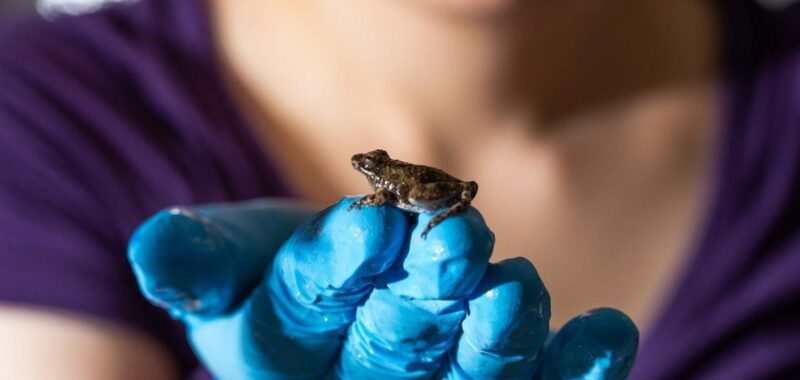January 30, 2025
2 min read
Watch a Frog Walk on Water with High-Speed Belly Flops
Tiny frogs seem to skim the water’s surface, but high-speed video reveals their secret

Graduate researcher Talia Weiss observes a cricket frog, whose unusual locomotion lets it appear to skip across the water’s surface.
If you flick a flat stone toward a pond at just the right angle, it skips across in a series of smooth jumps. Inch-long cricket frogs also seem to skitter over the surface of water with physics-defying grace. But when Talia Weiss, then a bioengineering graduate student at Virginia Tech, filmed the frogs with a high-speed camera, she saw a very different picture.
“The motion is so fast that if you look at it with the naked eye, you really can’t tell the difference,” Weiss says.
For a new study in the Journal of Experimental Biology, Weiss and her co-authors recorded skittering cricket frogs from above and below the surface at 500 frames per second and then played the videos back much more slowly. The researchers found that instead of hopping with just their feet breaking the surface, as older studies had described anecdotally, the frogs were actually doing a series of belly flops—sinking for a fraction of a second and then kicking themselves upward with each jump.
On supporting science journalism
If you’re enjoying this article, consider supporting our award-winning journalism by subscribing. By purchasing a subscription you are helping to ensure the future of impactful stories about the discoveries and ideas shaping our world today.

Slow-motion view of the cricket frog belly flop.
Rather than actually skittering across water like basilisk lizards do, the frogs were “porpoising”—leaping from the water as they swim. Weiss says their legs may be too slow for true surface hopping.
“To jump on the water surface, you have to have your legs retracted and ready to push down again by the time you’re approaching the water in every jump,” she explains. “And these [frogs] don’t prepare for their landing at all; they sort of just belly flop. They don’t retract their legs fast enough to immediately jump again” from the surface itself.
“Fast animal movements can be really deceiving,” and the new camerawork reveals what the frogs are actually doing, says Jasmine Nirody, an organismal biologist at the University of Chicago, who was not involved in the study. By carefully analyzing such motions, “we can think about how we might be able to use [the frog’s] strategy in various bioinspired robots,” she adds. “Now we know what to look for.”

